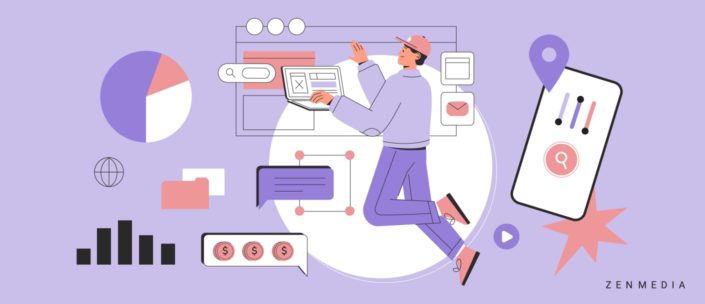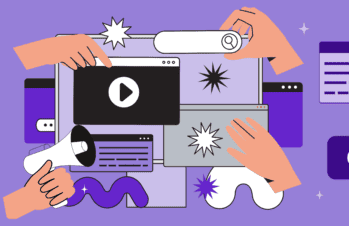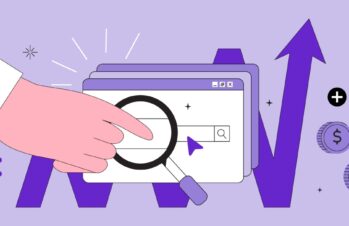The marketing and advertising landscape is changing. With the impending death of third-party cookies and other developments in data and privacy standards, brands must pivot their data strategies to maintain an advantage. How brands respond will dictate their ownership of data, which can be priceless if gathered and analyzed correctly. But what exactly does that mean for the B2B marketing industry? And how do self-serve ad platforms fit into this equation?
Essentially, our “cookieless future”—which prioritizes consumer data privacy above all else—increases the difficulty of serving ads and content effectively. Up until Google announced its transition away from cookies, claiming they’ve led to an “erosion of trust” with consumers, brands have relied on cookies and third-party data to present ads and content to the correct target audience. Without that data, it could make marketers’ and advertisers’ jobs like fishing with a dull stick and no bait.
Brands have relied on third-party data to inform marketing strategies and marketing tactics, including targeting in self-serve advertising. But with the developments in data and privacy standards, some brands are turning this tricky challenge into a business opportunity.
What is self-service advertising?
Self-service advertising is any medium or platform that allows advertisers to define the criteria for their ad campaign and purchase digital ad inventory without actually interacting with a sales representative. Examples of self-service ad platforms that many B2B marketers are familiar with include Google Ads and social ad networks like Facebook Ads and LinkedIn Ads.
Self-service advertising is generally a part of a media or advertising network—owned by the platform brands are advertising on. Social media networks, retail media networks, and the like are some examples. Amazon is a great example of a retail media network with a massive number of customers and a large amount of traffic; others include Walmart and Instacart. (This is similar to how Meta owns Facebook and Instagram ad platforms, making it a social media advertising network.) But some consumer-centric brands are getting in on the action too. CVS, for example, which launched its retail media network in August of 2020, gives advertisers a self-service platform to use and contribute to—CVS’s existing owned data.
As third-party data and cookies are eventually phased out, owning rich data sets will be pivotal for brands, helping to inform B2B paid advertising campaigns and other business decisions. As a huge bonus, it’s also a large revenue stream to manage a retail media network and become a self-serve ad platform. In fact, retail media ad spend is expected to jump 31% to nearly $41 billion this year, almost tripling from 2019, according to Insider Intelligence.
More recently, brands like DoorDash and Uber have also entered the chat. Both launched self-service ad platforms that use first-party data to target users in their respective apps, and these new ventures have proven successful. Uber is projecting its ad offering to bring in more than $1 billion by 2024, and DoorDash reported that it made $3 billion in “sales generated for merchants through ads and promotions” between July 2021 and Jun 2022.
Competing with traditional retail market networks, Uber and DoorDash are pioneering the mobility media market. Uber Journey Ads reported that more than 40 brands have signed on to test the platform’s new feature, including NBCUniversal and Heineken. And Uber’s early research touts that brands with 100% share of voice on the platform had two to six times the brand performance after just two minutes of exposure—offering an incentive for potential advertisers who haven’t entered Uber’s mobility advertising network yet.
The idea behind both DoorDash and Uber’s mobile advertising network is to target per trip or per order, directly engaging the consumer while simultaneously building and improving a first-party data set. In an interview with Campaign, the general manager for Uber’s advertising division, Dr. Mark Gerther, said the brand garnered 1.87 billion trips in the third quarter of 2022, meaning that, on average, they connected advertisers with consumers five times per month across rides and deliveries.
Five touchpoints is pretty helpful when you consider most consumers need an average of 27 touchpoints to convert.
So, what do the data developments mean for B2B marketers?
It means that when they search for ad solutions and plan digital campaigns, B2B marketers will have more options to consider to meet their audiences where they are at. Investing in advertising in a growing market, like the mobile media market, could give brands a huge advantage in share of voice—similar to how early adopters of social platforms and trends tend to be the most viewed.
In 2020, Forrester predicted any retailer with more than 500 million unique visitors to its website would be likely to create a media business. With all those options, brands will have more control over what ads they buy and how they buy them.
The future of self-serve advertising
While the customization that comes with self-serve advertising—in retail, social, and mobile markets—is appealing to brands, it’s also another contributing factor to the complexity of B2B marketing and managing a campaign. Imagine you are managing ads for a single campaign for a single brand, but you’re running ads on Uber, DoorDash, Walmart, and a variety of social media channels. That could be five to six different platforms to manage just one ad campaign, and that is bound to get overwhelming fast. It’s the marketing equivalent of canceling your cable and subscribing to streaming services like Netflix and Hulu, and after adding HBONow, Disney+, Apple TV and more you suddenly realize that somehow you’re spending more money now than when you paid for cable.
Software aggregators, like Criteo and CitrusAd, aim to consolidate these ad platforms into a single a single-access retail marketplace. But beyond that solution, there isn’t much to help marketers streamline their advertising allocations.
What about smaller B2Bs?
While smaller B2Bs certainly aren’t getting in on this by creating their own mobile media networks, they can still take advantage of the options available for targeting their audiences in new ways. Imagine the possible results of targeting your ad to a geographic location near an ongoing tech conference. If a smaller B2B were to use Uber or DoorDash’s self-serve ad platforms, it could solidify its brand presence for conference attendees who are Ubering around town or ordering food to their hotel rooms. It could even be an effective strategy for a smaller business that can’t afford to attend the conference to ensure they still have a presence amongst conference attendees.
No matter the size of your company, you can benefit from understanding and leveraging self-serve advertisements, especially if there’s an opportunity to collect first-party or zero-party data. With the continued growth of retail media markets and the beginning sparks of the mobile media market, there will no doubt be implications for B2Bs in 2023.
Wondering how to put your best ad forward in the mobile media market? Need a partner to manage all those campaigns? Reach out. We love that stuff.







